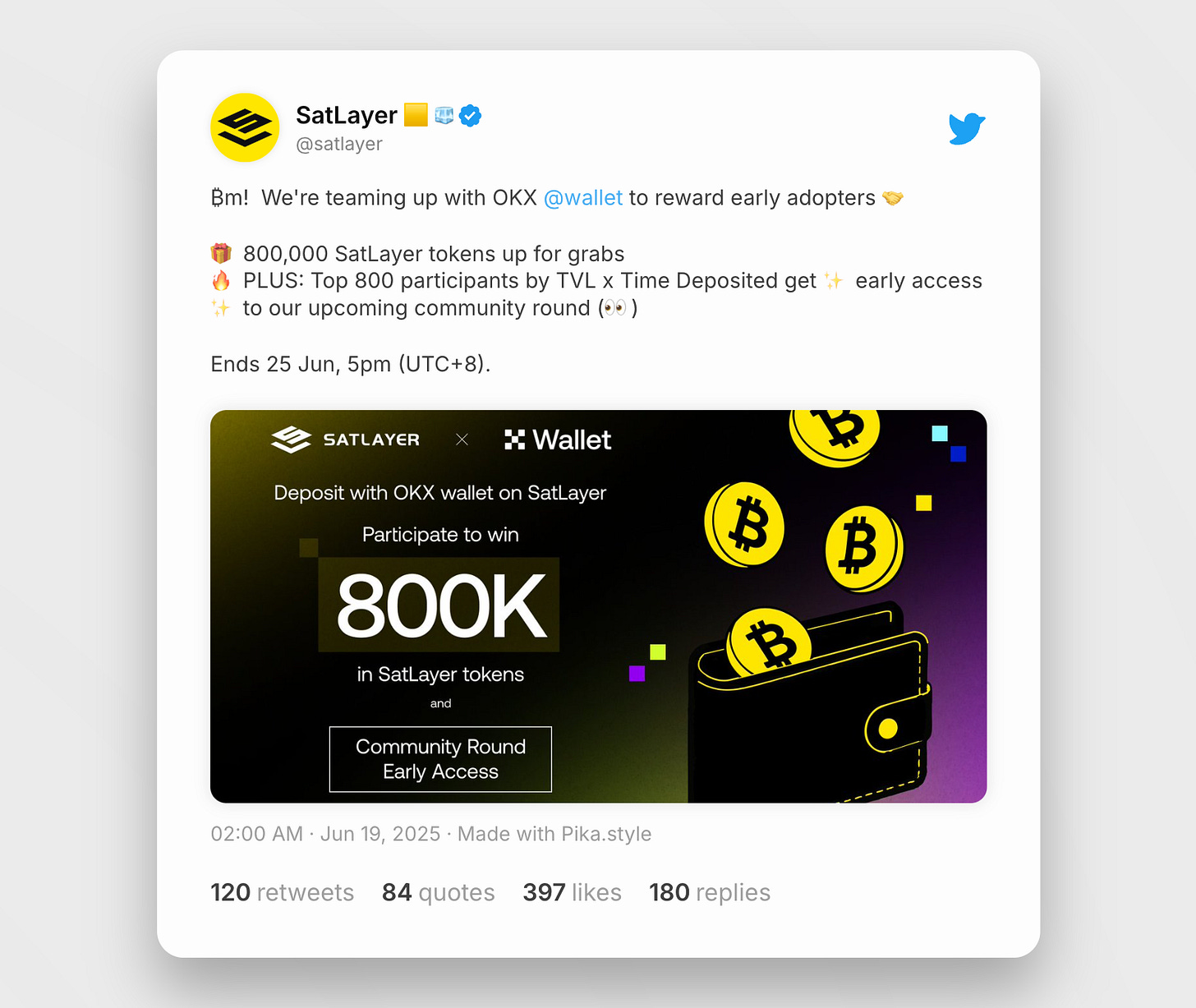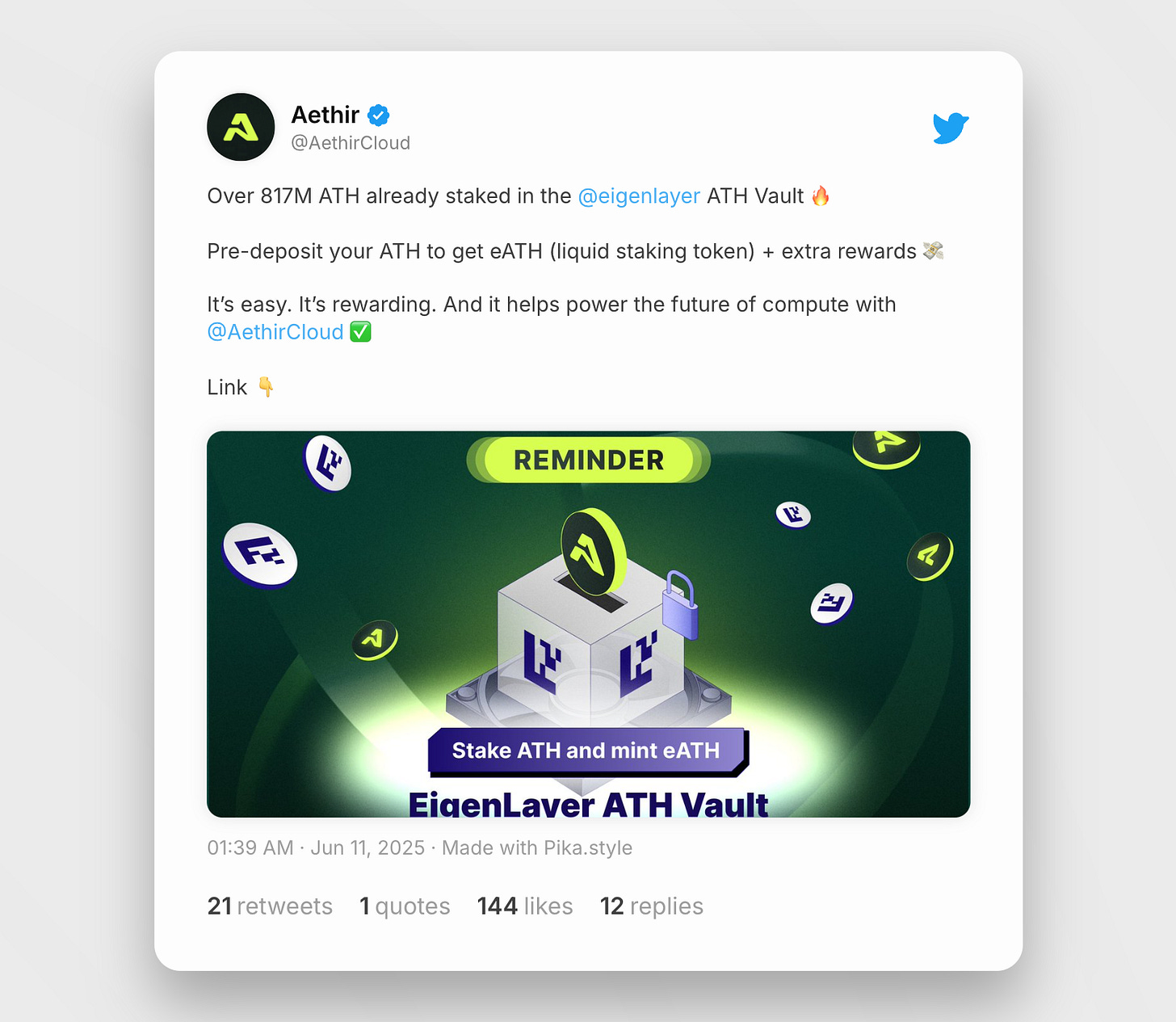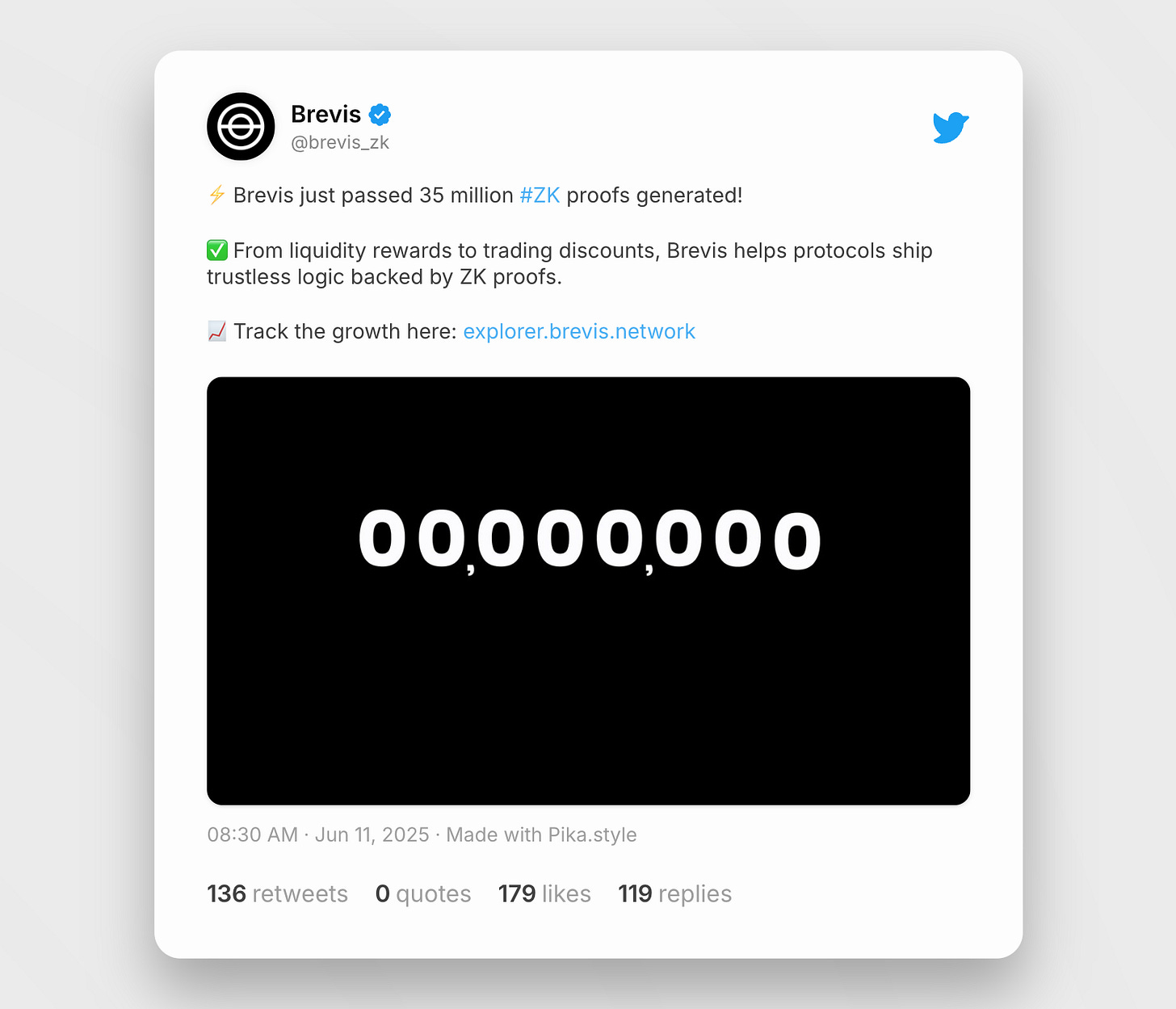Re:Staking Weekly #31
EigenCloud Rebrand & $70M Investment from a16z, Predicate x Paxos, Lagrange x Nvidia, Othentic Slashing, and Verifiability Design with Skate
Welcome to Issue #31 of Re:Staking Weekly! 👋
You’ve probably seen the headline, EigenLayer has rebranded to EigenCloud, signaling a bold move beyond restaking into the world of verifiable cloud infrastructure. Backed by a fresh $70 million investment from a16z, this pivot positions EigenLayer to directly challenge traditional cloud providers like AWS and Google Cloud.
In this issue, we break down what EigenCloud really means, how it impacts the AVS ecosystem, and why this may be one of the most important inflection points in restaking's evolution.
Also in this issue:
Predicate and Paxos publish a whitepaper on onchain compliance and regulatory alignment, timely as crypto enters a new era of scrutiny.
Skate Network’s Siddharth drops a thread breaking down how they approached verifiability, a core but often-overlooked piece of AVS design.
Othentic ships slashing support, unlocking a new level of economic security for the many AVSs already built on its framework.
Lagrange partners with NVIDIA, becoming the only crypto-native team working with them to deliver verifiable and secure AI.
Earnifi wins Best Financial Services App at the 2025 American Business Awards, powered by Opacity’s zkTLS network and EigenCloud.
…and more.
Let’s dive in! 🚀
EigenLayer Becomes EigenCloud: A Vercel Moment for Verifiable Services
This week, EigenLayer announced a series of major updates under a new name: EigenCloud.
Framed explicitly around the emerging verifiable compute thesis, the rollout includes two new product primitives — EigenCompute and EigenVerify — alongside a renewed $70 million investment from Andreessen Horowitz.
Taken together, these moves mark a strategic inflection point: more than just an expansion of EigenLayer’s capabilities, but a reframing of its core identity. What began as a coordination protocol for restaking is now positioning itself as a vertically integrated platform for verifiable services.
This shift shouldn’t come as a surprise to long-time readers. For months, we’ve noted EigenLayer’s steady progression from a generalized restaking layer toward a more opinionated product thesis — one focused on onboarding application developers, abstracting operator complexity, and ultimately owning the full stack of verifiable infrastructure.
With EigenCloud, the thesis is finally productized, narrative-aligned, and capital-backed.
Let’s break it down.
What’s New
1. $70M Strategic Investment from a16z
Andreessen Horowitz (a16z) has committed an additional $70 million to EigenLayer through a public acquisition of EIGEN tokens, subject to a lock-up period. This investment signals growing institutional confidence in EigenLayer’s long-term vision. It reflects a shift in perception from restaking as a financial primitive to verifiable services as a strategic infrastructure layer that expands web3 and connects with web2.
2. Expansion of the EigenPrimitives Framework
EigenLayer is launching two new primitives that significantly enhance its developer-facing capabilities:
EigenCompute provides a container-based compute environment that abstracts away the operational complexity of managing external operators. It enables developers to deploy custom logic with minimal setup, while EigenCloud handles execution and trust coordination. The model is comparable to existing serverless platforms like AWS Lambda or Cloudflare Workers, but with verifiability as a core feature.
EigenVerify introduces verification-as-a-service. Developers can integrate standardized verification modules directly into their applications, eliminating the need to design and maintain bespoke trust frameworks. This simplifies development and shortens the time-to-market for new verifiable applications.
These new primitives complement existing components such as EigenDA (for data availability) and the EIGEN token (for governance and off-chain forking). Together, they form a more complete infrastructure platform. While detailed technical documentation is still forthcoming, especially regarding operator interactions within EigenCompute or implementation details in EigenVerify, the direction is clear: simplify and standardize the developer experience with end-to-end product offerings instead of simple SDKs.
3. Verifiable Service Composition & Cross-chain Support
One of the less headline-grabbing, yet strategically important updates is the introduction of Verifiable Service Composition and Cross-Chain Support. Together, these features enable applications to interact with existing Actively Validated Services (AVSs) through a standardized API interface, with unified models for payment, authentication, and trust. Crucially, these services are now designed to operate across any L1 or L2, further expanding their applicability.
The best analogy comes from traditional cloud infrastructure. In AWS, developers can seamlessly combine services like S3 (storage), Lambda (compute), and IAM (identity). EigenCloud is now building toward the same modularity — enabling AVSs to be composed like building blocks. Rather than each AVS implementing its own custom interfaces for integration, every AVS can now plug into a shared framework. This standardization dramatically lowers the friction for developers and accelerates composability across the ecosystem.
If successful, this could trigger a flywheel effect: as more AVSs adopt the common interface, each one becomes easier to integrate, and every new AVS launched within EigenCompute instantly gains distribution across the existing service graph. What was once fragmented becomes interoperable. What was once siloed becomes synergistic.
This is the kind of infrastructure-level glue that, while subtle, compounds over tim. And this may prove to be one of the most important architectural decisions EigenLayer has made to date.
Why Now?
The decision to rebrand from EigenLayer to EigenCloud is not just about naming. It reflects a convergence of timing, strategic leverage, and opportunity — all of which make this the ideal moment to shift the narrative from restaking to verifiable services.
1. Timing: Crypto’s Entry into the Mainstream
Mainstream adoption of crypto is no longer theoretical. With the rise of stablecoins and regulatory clarity on the horizon, applications supporting stablecoin flows — from payments to fintech to gaming — are set to multiply. But scaling these apps on traditional L1s or rollups is expensive, complex, and often overkill for the trust guarantees they actually need.
Verifiable services offer a more efficient path to scale. They allow developers to build applications with trust-minimized guarantees, but without the cost or overhead of spinning up a new chain. In this context, EigenCloud becomes a logical backend for the “verifiable app” era, just as AWS was for cloud-native apps. (We covered this thesis in depth in Restaking Weekly #17).
2. Leverage: Restaking Was a Trojan Horse
The term "restaking" worked well with crypto-native audiences — VCs, validators, and yield-seeking participants all understood the value of unlocking dormant capital. But it has also become a limiting frame. Restaking is a financial primitive, not a product. It resonates with the supply side of crypto, but the long-term battle was always on the demand side: developers.
What EigenLayer is now undertaking, building a modular, generalized framework for verifiable services, is no less ambitious than inventing Solidity and Ethereum itself, perhaps even more. It’s a complete framework and service for programmable trust. The early restaking narrative created economic leverage, aligned stakeholders, and bootstrapped attention. But that phase is ending. The name EigenCloud signals the end of the restaking era and the beginning of the transition to the real endgame.
3. Opportunity: Institutional Power and the Path to Web2 Integration
As Marc Andreessen once noted, the most underappreciated leverage a venture capitalist has is power — the ability to amplify narratives, recruit top talent, and open critical doors. The $70 million Series B investment from a16z is just that. It is political and strategic endorsement from one of the most powerful firms in tech.
We’re already seeing the downstream effects. EigenLayer has begun hiring from major cloud providers like AWS and Azure. If the ambition is to become the bridge between Web2 and Web3 — to compete not just with blockchains, but with the cloud itself — this is the moment. The market timing, institutional alignment, and product maturity are converging.
Why EigenCompute and EigenVerify Matter Right Now
For verifiable services to scale — and for EigenLayer to fulfill its long-term vision — the developer experience needs to be radically simplified. Today’s application builders don’t just need trust guarantees; they need seamless access to multiple chains, external data, AI models, and storage. All of this must be easily deployable, secure, and performant. Until now, building on EigenLayer meant standing up and managing your own operator set — a high-friction requirement that excluded most developers.
EigenCompute and EigenVerify change that.
These new primitives offer a managed experience for building verifiable applications. Developers can now upload an app container and go — no need to provision operators or understand the intricacies of staking mechanics. It’s a model familiar to anyone who’s used AWS Lambda or Vercel Functions, but rebuilt for a verifiable, decentralized runtime.
Importantly, EigenCompute is optional. Developers who want to run their own infrastructure still can. But for the majority who prioritize speed and simplicity, EigenCompute becomes the default. EigenVerify complements this by offering plug-and-play verification services, further reducing development overhead and time to launch.
The Uphill Battle
The name change to EigenCloud is not just about narrative.
It strategically positions EigenLayer in a new category, one with a significantly larger total addressable market, where the competitive landscape shifts from crypto-native protocols to global cloud incumbents. While most restaking projects remain focused on bootstrapping validator supply and building yield narratives, EigenLayer has leapfrogged into the application-layer compute market. In doing so, it combines the trust guarantees of crypto with the usability and developer experience of modern cloud platforms, a positioning that few others in Web3 are even attempting, let alone executing on.
But this move comes with its own set of challenges.
Verifiability, is still early and confusing even for participants in crypto, let alone most developers. The vast majority of apps (including crypto apps) still live comfortably inside AWS and Google Cloud. For EigenCloud to succeed, it must not only offer a better experience, but it must also educate the market on why certain applications require cryptographic trust guarantees in the first place.
This is the real frontier and the hardest hill to climb: shaping developer consciousness around what trust, neutrality, and verifiability mean in the context of modern software.
Regardless, welcome to the end of the beginning and the beginning of something far more ambitious.
Farewell, restaking. Welcome, verifiable cloud.
Read More:
Sreeram’s cloud thesis of crypto thread
Protocol News
Latest updates on restaking protocol developments across the Ethereum, Bitcoin, and Solana ecosystems
Learn more about the technical design of Symbiotic Relay, which enables developers to stake seamlessly across multiple chains on Symbiotic.
SatLayer is partnering with OKX Wallet to distribute 800,000 SatLayer tokens as rewards.
Babylon is partnering with Kraken to launch BTC-native restaking directly within the Kraken app, allowing users to earn $BABY tokens as rewards.
AVS & Restaking Ecosystem
News on the latest AVS partnerships, feature releases, and innovations in the restaking ecosystem
With crypto going mainstream and regulation heating up, Predicate’s solution is more critical than ever. Read their whitepaper co-authored with Paxos.
Othentic introduces slashing to its AVS developer framework, a critical step toward secure and scalable adoption.
Verifiability design is often overlooked in AVS development. Siddharth from Skate Network shares a great thread on how they tackled this core security challenge.
Big win for Earnifi — the zkTLS-powered consumer finance app is named Best Financial Services App at the 2025 American Business Awards. Powered by Opacity Network and EigenCloud.
Hyperlane’s new MCP server allows AI agents to initiate cross-chain bridging through natural language prompts, unlocking a new interface layer for autonomous agents.
Lagrange stands alone as the only crypto partner of NVIDIA, focused on building verifiable and secure AI.
Over 817 million ATH tokens have been staked in the EigenLayer ATH vault. A massive milestone for the decentralized GPU vender’s checker network.
You can now track key EigenDA metrics directly on GrowthePie.
Brevis has successfully generated over 35 million zk proofs, a significant usage milestone for its ZK prover network.
Zeru has launched its zScore API, enabling developers to access onchain reputation data for specific user accounts.
Fermah has officially launched Phase 2 of its ZK prover market testnet.
Infura’s DIN network is collaborating with AltLayer to build a verifiable, EigenCloud-integrated RPC layer for enhanced trust and transparency.
That's it for this week's newsletter! As always, feel free to send us a DM or comment directly below with your thoughts or questions.
If you want to catch up with the latest news in the restaking world, give our curated X list a follow!
See you next week and thanks for reading,






















